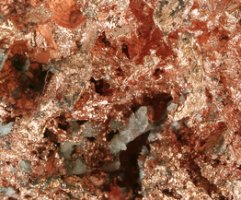
February Editorial
Finding Copper

February Editorial
Finding Copper
|
|
Though we hear of copper cable being replaced by fibre in modern communications, this does not mean that copper is becoming less important in the modern world. Quite the opposite. Copper is used extensively in so many aspects of modern life that demand for copper is rapidly increasing. In fact, although copper has been used for the last 10,000 years, more than 95% of the copper mined in human history was extracted from the earth in the last 100 years. Even more alarming, more than half of that copper was extracted in just the last 24 years.The demand for copper is increasing almost exponentially. |
|
|
Most of the copper produced today comes from so-called 'porphyry copper' deposits. These copper ores are formed from hydrothermal fluids that originate deep in the planet's magma chamber. The ores are associated with intrusions of magma into the crust above subduction zones. For this reason most deposits are found near volcanic arcs - the chain of volcanoes which develops above a subducting plate, for example the infamous Ring of Fire, the volcanoes around the Pacific Ocean. However, the connection between volcanoes and copper ore has never been very clear. For example, copper ore is predominantly found in the form of copper-iron sulphides and yet volcanoes which are rich in copper tend to be low on sulfur and vice versa. However, a new study (ref) from Bristol School of Earth Sciences, in collaboration with BHP Billiton, the world's largest mining company, has proposed a two-step model which not only explains the apparent conundrum, but should also help in the search for new copper deposits. This two-step model proposes that with copper enrichment the first step happens in magmatic hyper-saline liquids. These liquids are 'brines' which, for tens of thousands of years, have been separated from magma and trapped in the crust few kilometers below the earth's surface. In the second step, short-lived bursts of sulphur-rich gases are released from the underlying mafic magmas in the same volcanic system. When the sulphur-rich gases meet the brines, there is an explosive reaction which results in the formation of copper sulphide ores. To prove their theory, the scientists used high-temperature and high-pressure laboratory experiments to stimulate these gas-brine interactions. At magmatic temperatures of 700-800oC, the experiment produced copper-iron sulphide minerals with hydrogen chloride gas as a byproduct. Subsequent studies showed that the texture and chemical characteristics of the copper ore produced in the laboratory resembles those in porphyry copper deposits. Consequently the authors concluded that porphyry copper ore forms in a two-step process of brine enrichment followed by gas-induced precipitation. Professor Jon Blundy of the University of Bristol and the lead author of this paper commented: This is a remarkable result with far-reaching implications for how we go about searching for new copper deposits.' Journal Reference: | |
| _______________________________ | ||||
| Home | | | Shopping | | | Database |
© Biscuit Software 2004-2015
All rights reserved